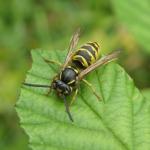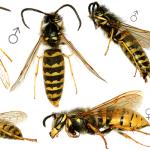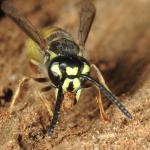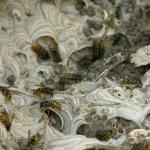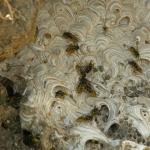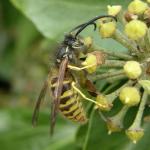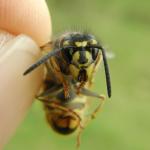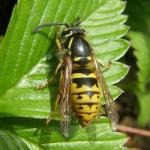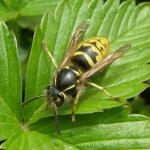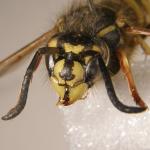Vespa alascensis PACKARD1870; Vespa communis DE SAUSSURE 1857; Vespa pseudogermanica STOLFA 1932; Vespa sexcincta PANZER 1799; Vespa westwoodii SHIPP 1893
Our second very common social wasp with a short oculo-malar space (see V. germanica) which is also a frequent pest. For keys and biology, see V. germanica profile.
Similar to V. germanica in England, but more widely distributed in Wales, Scotland and Ireland. Recently recorded from Orkney and Shetland.
Common in Europe and Palarctic Asia as far north as the Actic Circle, and east to Japan. In North America, it is found from about 69°N in Canada, south to New Mexico and northern Georgia. It was introduced into south-eastern Australia and New Zealand, where it has become an important pest. This wasp also occurs in Hawaii (Maui Island, above 1200m) (Archer 1998, Edwards 1980).
This species is not regarded as being scarce or threatened. As with V. germanica, this species has also declined (Archer 2001), but not so markedly until the late 1990s.
Found in many types of temperate habitats.
Similar to V. germanica, although workers are usually about a month later in making their appearance (Edwards 1980). Some colonies overwinter, dying out in early spring.
In common with all other social wasps, the workers catch various insects and spiders which are malaxated (chewed up) and fed to the larvae.
Nest sites are mostly underground with entrance tunnels often much longer than those of V. germanica, sometimes reaching 45cm in length. Much more common than V. germanica in roof spaces, where the nests can be up to 1.2m across. The nest envelope is variously coloured yellowish to brown due to the workers collecting both rotted and fairly sound wood fibres (cf. V. germanica). Average sized mature colonies of V. vulgaris have about 7500 small cells and 2300 large cells. They rear about 10000 workers, 1000 queens and 1000 males. By comparison, V. germanica colonies are smaller, with about 6500 small cells and 1500 large cells, from which are reared about 8000 workers, 1300 queens and 3200 males (M Archer pers. com.).
Similar to V. germanica.
The roundworm Pheromermis pachysoma, the fly-like beetle Metoecus paradoxus, the conopid fly Leopoldius coronatus and the ichneumonid wasp Sphecophaga vesparum are recorded as parasites of this species (Edwards 1980, smith 1969).
2002


